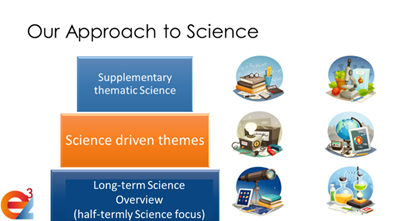Science
The Trust has a three-tiered approach to science that drives our approach.
Looking for a reception place at a GOOD school with OUTSTANDING features? Limited places available for September 2024 intake.
Call now to book a visit – 0121 556 0340.
The Trust has a three-tiered approach to science that drives our approach.

The first tier is the long-term science overview outlined below. These have been carefully mapped to each of the themes within the E3L curriculum that are taught in each half term. However, science is taught separately to pupils’ theme work.
The second tier are the science-driven themes e.g. Galaxy Quest in Year 5. With these themes, the science is taught as part of the theme.
The final tier is the supplementary thematic science included in the themes. Certain Explores are given a science focus thus adding extra science into the curriculum.

| Autumn 1 | Autumn 2 | Spring 1 | Spring 2 | Summer 1 | Summer 2 | |
| Year 1 | Seasonal Change | Everyday materials | Animals, including humans (Identify, name and draw and label the basic parts of the human body and say which part of the body is associated with each sense) |
Plants | Animals, including humans (Carnivores, herbivores, omnivores Everyday materials Focus on natural materials: wood, water and rocks) |
Animals, including humans (Describe and compare the structure of a variety of common animals including pets) |
| Year 2 | Plants | Uses of everyday materials (Find out how the shapes of solid objects made from some materials can be changed by squashing, bending, twisting and stretching.) |
Uses of everyday materials | Living things and their habitats | Animals, including humans | Uses of everyday materials (Identify and compare the suitability of a variety of everyday materials) |
| Year 3 | Forces and Magnets | Rocks (Rocks and soils) |
Animals, including humans | Plants | Light | Rocks (Rocks And fossils) |
| Year 4 | Sound | States of matter 1)Solids, liquids, gases 2)Heating and cooling |
Electricity | States of matter (water cycle) |
Animals, including humans 1)Digestive system 2) Teeth and functions |
Living things and their habitats |
| Year 5 | Animals, including humans (Describe the changes as humans develop to old age) |
Forces (Gravity / air resistance and friction) |
Earth and Space | Forces (Recognise that mechanisms including levers, pulleys and gears allow a smaller force to have a greater effect) |
Living things and their habitats (Lifecycles of mammals and insects linked to the plague) |
Properties and changes of materials |
| Year 6 | Evolution and Inheritance | Living things and their habitats | Animals, including humans (Heart and circulatory system) |
Animals, including humans (Recognise the impact of diet, exercise, drugs and lifestyle on the way their bodies function) |
Electricity | Light |